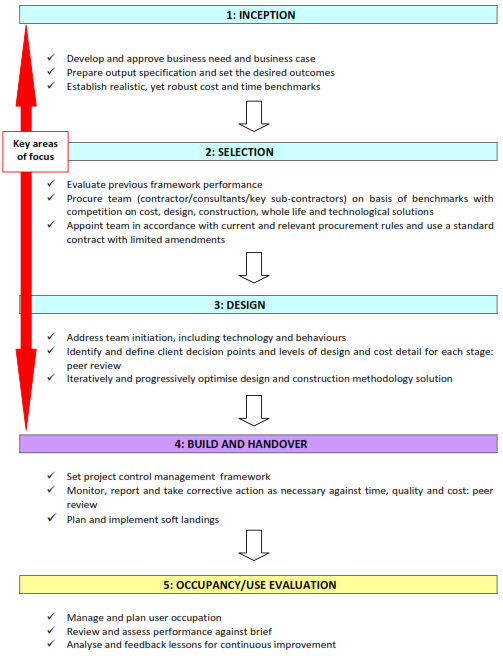Cost led procurement
Contents |
[edit] Introduction
The main aims of the Government Construction Strategy were to ‘change the relationship between Clients and Industry’ and achieve a 15-20% reduction in public sector construction costs by 2015. The Government Construction Task Group report 2012 developed three potential new strategies to help achieve these aims:
- Cost Led Procurement (CLP).
- Integrated Project Insurance (IPI).
- Two Stage Open Book.
All three involve early contractor involvement, transparency and integration. Along with a reduction in costs, they are expected to contribute to a reduction in project risk, improved programme accuracy and an enhanced working relationship between client and the supply chain.
[edit] Background
The Cost Led Procurement method is ‘...intended to allow industry to use its experience and knowledge to develop innovative solutions through leveraging design, materials, subcontracting, direct labour and experience to the advantage of the Public Sector Client...focused on achieving target costs whilst maintaining, if not improving value’ (Cabinet Office, 2014).
In Cost Led Procurement, the project details are clearly identified and a ceiling cost calculated. Typically, an integrated supply team (one or more) is identified through a framework agreement and the team work together to complete the project at below the ceiling cost. In subsequent similar projects within a framework, Cost Led Procurement offers the opportunity for further reduction of costs.
The project is offered to suppliers outside the framework if none of the existing teams are able to deliver the project below the ceiling cost.
[edit] Structure
The CLP plan involves five phases:
- Inception.
- Selection of contractor.
- Design and cost development.
- Construction.
- Operation
The flow chart from the 2014 Cabinet Office publication, Cost Led Procurement Guidance outlines the process.
[edit] Trial projects
Two trial projects were run using the CLP method: Upper Mole and Rye Harbour. The Rye Harbour scheme was successful in achieving a 6% saving through reducing the project programme.
This article contains public sector information licensed under the Open Government Licence v2.0 ref Cabinet Office, Cost Led Procurement Guidance 2014.
[edit] Related articles on Designing Buildings Wiki
- Framework agreement.
- Government construction strategy.
- Integrated project insurance.
- Integrated supply team.
- Managing the procurement process.
- Optimised contractor involvement.
- Procurement route.
- Supply chain.
- Supply chain management.
- Sustainable procurement.
- The benefits of e-procurement in construction.
- Two stage open book.
- Value for money.
[edit] External references
Featured articles and news
The UK’s largest air pollution campaign.
Future Homes Standard, now includes solar, but what else?
Will the new standard, due to in the Autumn, go far enough in terms of performance ?
BSRIA Briefing: Cleaner Air, Better tomorrow
A look back at issues relating to inside and outside air quality, discussed during the BSRIA briefing in 2023.
Restoring Abbotsford's hothouse
Bringing the writer Walter Scott's garden to life.
Reflections on the spending review with CIAT.
Retired firefighter cycles world to raise Grenfell funds
Leaving on 14 June 2025 Stephen will raise money for youth and schools through the Grenfell Foundation.
Key points for construction at a glance with industry reactions.
Functionality, visibility and sustainability
The simpler approach to specification.
Architects, architecture, buildings, and inspiration in film
The close ties between makers and the movies, with our long list of suggested viewing.
SELECT three-point plan for action issued to MSPs
Call for Scottish regulation, green skills and recognition of electrotechnical industry as part of a manifesto for Scottish Parliamentary elections.
UCEM becomes the University of the Built Environment
Major milestone in its 106-year history, follows recent merger with London School of Architecture (LSE).
Professional practical experience for Architects in training
The long process to transform the nature of education and professional practical experience in the Architecture profession following recent reports.
A people-first approach to retrofit
Moving away from the destructive paradigm of fabric-first.
International Electrician Day, 10 June 2025
Celebrating the role of electrical engineers from André-Marie Amperè, today and for the future.
New guide for clients launched at Houses of Parliament
'There has never been a more important time for clients to step up and ...ask the right questions'
The impact of recycled slate tiles
Innovation across the decades.
EPC changes for existing buildings
Changes and their context as the new RdSAP methodology comes into use from 15 June.
























